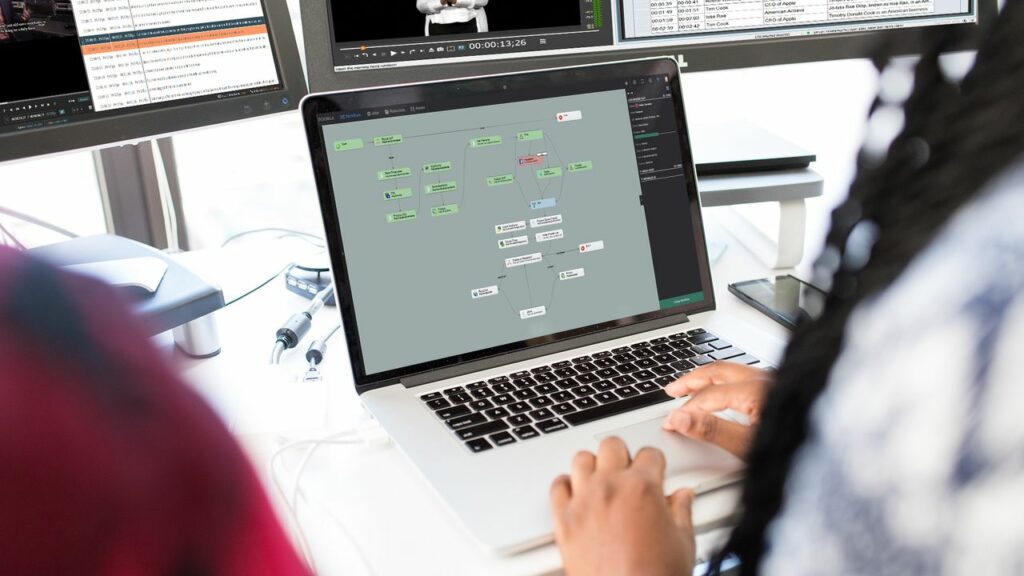This article was first published on the SMPTE website by Michael Goldman, Board Member at SMPTE. This is based on an interview of Lincoln Spiteri, VP of Engineering, Ooyala at Dalet.
In the opinion of Lincoln Spiteri, VP of Engineering at Dalet, a major manufacturer of media workflow technology solutions, the OTT video content streaming revolution is currently in a vibrant, but dichotomous place. On the one hand, many technological, logistical, and standardization aspects of securely delivering scaled content over the internet to consumer devices or businesses are now stable and are burgeoning at this point, so that more creators and distributors than ever can efficiently push their programming to the public. The current growing global dependence on streaming news, sports, entertainment content, meetings and personal interactions during the ongoing worldwide emergency, for example, illustrates how “established” OTT streaming has become.
Disruptive forces and the new possible
On the other hand, significant “disruptive forces,” as he puts it, have evolved what are possible, needed, expected, and desired out of the video-streaming paradigm. This means, in essence, that no sooner have established methodologies proliferated than new questions and answers start hurtling down the chute that can change some of those methodologies over time.
“The delivery side has settled overall,” Spiteri says. “We have the means to deliver high bandwidth, so the adaptive streaming side is there. Edge providers like Akamai and AWS Cloudfront, among others, and also cloud services being offered by the likes of Amazon, Google, and Microsoft Azure are providing the ability to anyone who wishes to deliver content over the top via the internet to be able to do so. In terms of delivering generalized services, all the building blocks are now understood, and they are on the verge of becoming commoditized in many new ways. It’s a global phenomenon where people are consuming video on an incredibly large scale.
“But if you think about the disruption that Netflix and others have brought about in terms of being able to monetize their platform on such a large scale, by providing incredibly high-quality video and, nowadays, producing content themselves, I think that also drove the adoption, because consumers ultimately tend to gravitate to quality. On one side, you have big content producers spending billions of dollars to create compelling, original content they can distribute [online]. But then, on the other hand, you have the ongoing phenomenon of YouTube, which probably offers the most video content on the Internet in terms of volume. And a lot of that is from small-time content makers—homegrown content. The need for those people to also be able to produce and distribute is an interesting development from a technological point of view.

“So there is something to be said about knowing what happens upstream in terms of acquiring or producing content [for distribution on the Web]. But the question arises, how do you do that efficiently to meet all sorts of different criterion at different distribution points, when targeting all sorts of different devices and platforms?”
Managing digital video assets more efficiently
Spiteri says the answer lies in figuring out how to manage digital video assets more efficiently all along the chain. “You have to have a good grip on your assets and have good metadata describing those assets,” he adds. “You need a way to prepare assets for consumption on a wide variety of devices and media platforms. That allows you to go back into your archive, and basically monetize not just the new content you are making, but also your existing assets.”
Thus, among other developments, manufacturers like the company Spiteri works for, Dalet, and others are pushing into the marketplace various “media logistics platforms,” which he calls “the orchestration piece of the streaming puzzle,” designed, he says, “to make it easier and less costly to manage, package, and distribute content.”
After all, he says, we live in a world where content not only has to be streamed, but in fact, has to be captured, edited, packaged with robust production values intact, and distributed or re-distributed to a wide range of destinations, often in a matter of minutes. Some examples of such platforms come from companies like Dalet, SDVI Corp., and Ownzones, among others.
“For news and sports especially, time is of the essence,” he says. “That’s what I mean about ‘orchestration.’ We have a sports client in the UK, and they are required as a virtue of their license to deliver clips from a game within, say, five minutes of the event happening. This could be a two-minute package that needs to be sent off to perhaps 100 licensees to use [as highlights]—the package will be placed on someone’s Web platform or their applications for mobile consumption. So these orchestration platforms are needed to drive those sorts of things—to capture, edit, and produce packages within minutes out of a live event, and then enable it to be distributed immediately in a format that is the right format for whomever is receiving that package. So the development of tools that can make streaming of such content fast, robust, reliable, and scalable is very important.”
In other words, tools that can “bring in a high level of automation” on the front end are now helping to democratize the streaming revolution, Spiteri suggests.

“The idea is we can marry the media asset management side with metadata and with orchestration so that you can bring in that high level of automation, be able to prepare packages and, at the same time, make sure they are being reviewed for compliance purposes and then be ultimately delivered to whomever is putting the material online,” he explains.
Spiteri emphasizes that the content industry has invested heavily in recent years in not only managing and protecting data, but in ways of tracking their users viewing habits and interests. That’s why, he suggests, you will often see content streaming providers “behaving like digital agencies to a certain extent, readily experimenting with their user interfaces to see what is working and to understand what their customers are viewing. They have a sophisticated level of analytics for that sort of thing, gathering an amazing amount of data.”
Related to all this, Spiteri feels it is inevitable that artificial intelligence tools will “naturally play a bigger part” in how this data on users is gathered and taken advantage of, as well as how content is packaged and streamed around the world going forward. He points to new initiatives from several companies trying to weave AI tools into the video streaming tapestry. These include his company, Dalet, Amazon, Azure, and Graymeta. Further, some industry players are taking advantage of open-source AI learning framework services such as Tensorflow, developed by Google, and Facebook’s Pytorch, among others.
“The AI community is definitely growing at a fast rate, now that we can run things through the Cloud,” he says. “So I think we will see some interesting applications of AI coming, as a result, with innovations combining analytics coming from users and helping companies learn about usage patterns and things like that.”
On the importance of cyber-security
He particularly feels that the security issue for content distributors has also largely stabilized in terms of delivering material over encrypted channels, thanks to established digital rights management (DRM) standards and services, including Google Widevine, Microsoft Playready, Apple FairPlay, and Adobe Content Server, among others. Additionally, he points to an increasing trend across the industry whereby companies are joining forces to develop new and more stringent cyber-security protocols, such as the DPP initiative and the Trusted Partner Network.
“All the major means of delivery allow you to deliver encrypted content—I think that is pretty much a done game,” Spiteri says. “Those things are very robust at this point. They are still evolving, but there is no magic sauce. They use the fabric of the Web itself—the core technologies are acting as part of a framework and infrastructure that allow us to deliver content at scale. And now, various CDN’s [content delivery networks] allow you to essentially geo-fence your content [using geographically distributed servers to transport files] so that it can’t be touched by anyone outside the region it is intended for. So we have all sorts of mechanisms for providers to understand who their users are, what their level of access should be, and they are all very mature at this point with well-established operators and practices.”
Iterate and innovate
Still, he expects the industry “to continue to iterate and innovate” in terms of user interfaces and other ways of simplifying the experience, with greater use of voice control technologies and more powerful, AI-powered content recommendation engines on the way, among other things.
Spiteri says other interesting advancements coming down the chute include increased reliance for some providers on the notion of an API-first platform—what he calls “a headless OVP” for certain kinds of applications.
“There are various companies, including one called Mux, that are built around the idea of having an easier way for the technology needed to deliver content to be more open with API-first delivery,” Spiteri relates. “I think we will see more of these in the near future. They are not necessarily there to build the best content management system, or to provide an end-to-end tool chain to let anyone who wants to build an OTT platform to do so, but they focus very specifically on a particular piece and make it as good as it can be.”
He also emphasizes that the evolution of adaptive bit rate streaming standards such as MPEG-DASH, Apple’s HLS (HTTP Live Streaming), Microsoft Smooth Streaming, and others has “removed a lot of the fragmentation” in the video streaming world. By that, Spiteri means that, “it’s now fairly easy to be able to package your content and scale it up or down based on the conditions the stream is being delivered in.”
Thus, Spiteri largely feels that the standardization issue in the streaming world is not an impediment anymore on a mixed-platform landscape. However, more generally, he also points out that what has really changed is the fact that, in this realm, “a significant part of the standards is carried by software now, not hardware. Devices can be upgraded over the air to fix certain issues or meet certain changes in a standard now. Therefore, the whole dynamic is changing. TV’s, phones, tablets are so powerful these days that the standards have to become agile. We can’t wait four or five years anymore for a new standard to be developed.”
And related to that, he points out that the OTT side of things will, for the foreseeable future, remain linked to one degree or another to the OTA side of things due to the “bigger role that OTA still plays when it comes to live events—it’s typically more reliable for sporting events and so on. So OTA still has room to grow, as well.”
As a consequence, the ATSC 3.0 next-generation terrestrial TV broadcast standard’s growth and evolution in the US is having an impact also in the streaming world, as discussed in Newswatch in 2019, because of the hybrid nature of the viewing landscape for the foreseeable future.
“Many companies are beginning to mix streaming content with live channels,” he says. “I’m sure several of the platforms are heading that way. In the UK, we have a service called TalkTalk, for example, which has created a pretty seamless mixture of over-the-air and over-the-top means of delivering content to the set-top box. Their software makes it pretty indistinguishable, whether you are receiving a channel over IP or a broadcast coming from your cable.
“Ultimately, this is due to the set-top box technology, or the new Smart TV technology generally. With the processors they are putting into these things now, it gives them a lot of power and the ability to make the experience pretty seamless.”
At the end of the day, Spiteri expects “more disruption from the content delivery side” over time.
“They want more 8k content, but it is questionable whether there will be much 8k content in the next year or two,” he says. “But we can probably expect a lot more 4k content, more high dynamic range content, and that sort of thing. But we will also see a market disruption in terms of new players coming into the fore. In other words, there will be more disruption because the technology is now able to deliver the content more efficiently for more people to give it a try.”
Featured in: Dalet Flex | OTT | Streaming |
Lincoln Spiteri heads the engineering team responsible for the development of Dalet Flex (formerly the Ooyala Flex Media Platform). Prior to the acquisition of Ooyala by Dalet, he was a member of Ooyala’s executive team responsible for R&D, engineering, and security. He has over 20 years of experience building software, leading engineering teams and operations across industries.
More Articles By Lincoln




